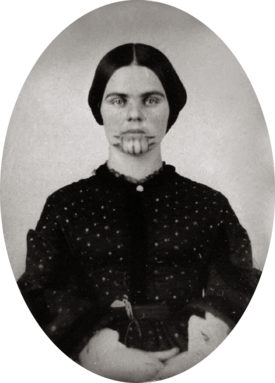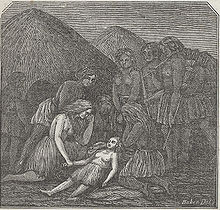- Olive Oatman
-

Nationality American 
Religion Mormon Parents Royce Oatman, Mary Ann Oatman Olive Oatman (1837-1903) was a woman from Illinois who was famously abducted by a Native American tribe (likely the Yavapai people), then sold to another (the Mohave people).[1] She ultimately regained her freedom five years later. The story resonated in the media, partly owing to the prominent blue tattooing of Oatman's face by her captors. In subsequent years, the tale of Olive Oatman came to be retold with dramatic license in novels, plays, and poetry.[2]
Contents
Early life
Born into the family of Royce and Mary Ann Oatman, Olive was one of ten siblings. She grew up in the Mormon faith.
In 1850 the Oatman family joined a wagon train led by James C. Brewster, a member of the Church of Jesus Christ of Latter-day Saints (LDS), whose attacks on, and disagreements with, the church leadership in Salt Lake City, Utah, had caused him to break with the followers of Brigham Young in Utah and lead his followers — Brewsterites — to California, which he claimed was the "intended place of gathering" for the Mormons.
The Brewsterite emigrants, numbering 52, left Independence, Missouri, August 9, 1850. Dissension caused the group to split near Santa Fe, with Brewster following the northern route. Royce Oatman and several other families chose the southern route via Socorro, Santa Cruz, and Tucson. Near Socorro, Royce assumed command of the party. They reached New Mexico early in 1851 only to find the country and climate wholly unsuited to their purpose. The other wagons gradually abandoned the goal of reaching the mouth of the Colorado. The party had reached Maricopa Wells when they were told that the Indians ahead were very bad and that they would risk their lives if they proceeded further. The other families resolved to stay. The Oatman family, eventually traveling alone, was decimated in what became known as the "Oatman Massacre" on the banks of the Gila River about 80–90 miles east of Yuma in what is now Arizona.
Oatman Massacre
Royce and Mary had seven children at this time, ranging in age from 16 to one year. On their fourth day out, they were approached by a group of Indians, asking for tobacco, food and rifles. At some point during the encounter, the Oatman family was attacked by the group, and all were killed except Lorenzo, age 15, who was clubbed and left for dead; Olive, age 13; and Mary Ann, age 7. Lorenzo awoke to find his parents and family dead, but no sign of Mary Ann and Olive. He eventually reached a settlement where he was treated. Three days later, Lorenzo, who had rejoined the emigrant train, found the bodies of his slain family; "we buried the bodies of father, mother and babe in one common grave." (The Tucson Citizen, September 26, 1913) The men had no way of digging proper graves in the volcanic rocky soil, so they gathered the bodies together and formed a cairn over them. It has been said the remains were reburied several times and finally moved to the river for reinterment by Arizona pioneer Charles Poston.[3]
Abduction and Captivity
Once the attack was complete, the Indians took some of the Oatmans' belongings along with the Oatman girls. The captors were either Tolkepayas or Western Yavapais living in a village nearly 100 miles from the site of her parents' death. After arrival, the girls at first were treated in a way that appeared threatening, and Olive later said she thought she would be killed. Eventually, the girls were used to forage for food, lug water and firewood, and other menial tasks. Miscommunication resulted in beatings.
After a year, a group of Mohave Indians visited the village and traded two horses, vegetables and blankets for the captive girls, after which the girls went on a 10-day journey to the Colorado River and the Mohave village. They arrived into what today is Needles, California. Once there, their calvary stopped for some time, as they were taken in by the family of Chief Espanesay. This tribe was more prosperous than the girls' prior holders, and the chief's wife and daughter took an interest in the Oatman girls' welfare. The girls were given plots of land to farm and were both tattooed on their chins and arms in keeping with the tribal custom.
About a year later, during a drought in the region, the tribe experienced a shortage of food supplies and Mary Ann died of starvation, at the age of 10.
When Olive Oatman was 16 years old, a Yuma Indian messenger arrived at the village with a message from the authorities at Fort Yuma. Rumors suggested that a white girl was being held captive by the Mohaves and the post commander requested her return. Blankets and horses were sent for trade, but the Indians initially resisted the terms.
Later life
In the end it was decided to take the trade items, and Olive was escorted to Fort Yuma in a 20-day journey. Before entering the fort, Olive insisted she be given proper clothing, as she was clad in nothing more than a grass skirt made of bark. Inside the fort, Olive was surrounded by cheering people. She soon discovered her brother Lorenzo was alive and had been looking for her and her sister. Their meeting made headline news across the West.
In 1857, a pastor named Royal B. Stratton wrote a book about Olive and Mary Ann. The book sold 30,000 copies, a best-seller for that era. In November, 1865, Olive married John B. Fairchild. Though it was rumored that she died in an asylum in New York in 1877, she actually went to live with Fairchild in Sherman, Texas, where they adopted a baby girl, Mamie.
Rumors of Olive Oatman being raped by the Yavapai were denied vehemently, leading her to declare in Stratton's book that "to the honor of these savages let it be said, they never offered the least unchaste abuse to me".
In 1981, a writer named Richard Dillon reported in a famous western magazine that there was evidence that Olive had told a friend that she was married to the son of the Mojave chief and that she gave birth to two boys when married to him. This account was never verified.
Olive Oatman Fairchild died of a heart attack on March 21, 1903, at the age of 65. The town of Oatman, Arizona, is named in her honor.
References
- Leo Banks, Stalwart Women: Frontier Stories of Indomitable Spirit (ISBN 0-916179-77-X)
- "Oatman Cookbook, History and Ghost Stories" - Written by the residents of modern day Oatman.
External links
- Tintype portraits of Olive Oatman and Lorenzo D. Oatman held in the collection of the Beinecke Rare Book & Manuscript Library at Yale University.
- Olive Oatman at Find a Grave
Categories:- 1837 births
- 1903 deaths
- American Latter Day Saints
- Kidnapped American people
- Yuma War
- Captives of Native Americans
Wikimedia Foundation. 2010.

